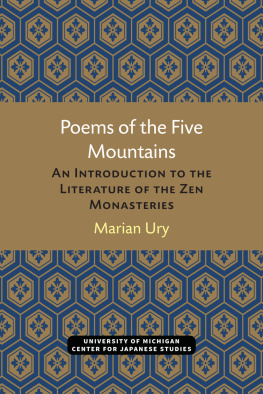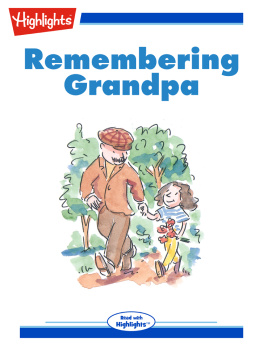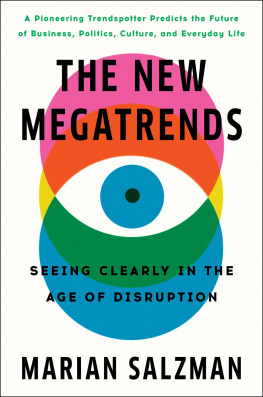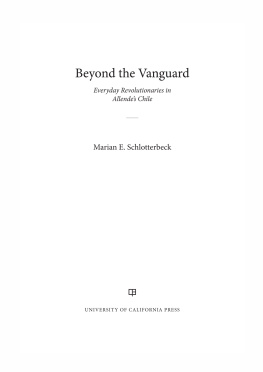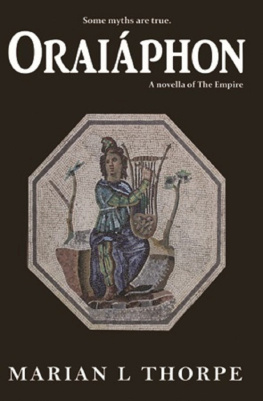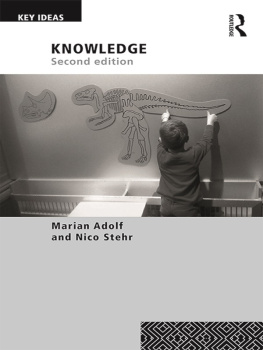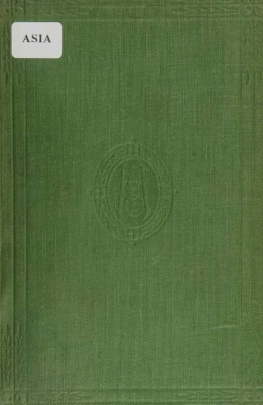Marian Ury - Tales of Time Now Past
Here you can read online Marian Ury - Tales of Time Now Past full text of the book (entire story) in english for free. Download pdf and epub, get meaning, cover and reviews about this ebook. year: 1979, publisher: University of Michigan Center for Japanese Studies, genre: Religion. Description of the work, (preface) as well as reviews are available. Best literature library LitArk.com created for fans of good reading and offers a wide selection of genres:
Romance novel
Science fiction
Adventure
Detective
Science
History
Home and family
Prose
Art
Politics
Computer
Non-fiction
Religion
Business
Children
Humor
Choose a favorite category and find really read worthwhile books. Enjoy immersion in the world of imagination, feel the emotions of the characters or learn something new for yourself, make an fascinating discovery.
- Book:Tales of Time Now Past
- Author:
- Publisher:University of Michigan Center for Japanese Studies
- Genre:
- Year:1979
- Rating:4 / 5
- Favourites:Add to favourites
- Your mark:
- 80
- 1
- 2
- 3
- 4
- 5
Tales of Time Now Past: summary, description and annotation
We offer to read an annotation, description, summary or preface (depends on what the author of the book "Tales of Time Now Past" wrote himself). If you haven't found the necessary information about the book — write in the comments, we will try to find it.
Marian Ury: author's other books
Who wrote Tales of Time Now Past? Find out the surname, the name of the author of the book and a list of all author's works by series.
Tales of Time Now Past — read online for free the complete book (whole text) full work
Below is the text of the book, divided by pages. System saving the place of the last page read, allows you to conveniently read the book "Tales of Time Now Past" online for free, without having to search again every time where you left off. Put a bookmark, and you can go to the page where you finished reading at any time.
Font size:
Interval:
Bookmark:

Michigan Classics in Japanese Studies, Number 9
Center for Japanese Studies
The University of Michigan
TALES OF TIME NOW PAST
Sixty-Two Stories from a Medieval Japanese Collection
MARIAN URY
CENTER FOR JAPANESE STUDIES
THE UNIVERSITY OF MICHIGAN
ANN ARBOR, MICHIGAN
Open access edition funded by the National Endowment for the Humanities/Andrew W. Mellon Foundation Humanities Open Book Program.
1979 by Marian Ury
Reprinted in 1993 with the permission of Marian Ury by the Center for Japanese Studies, 108 Lane Hall, The University of Michigan, Ann Arbor, MI 481091290
Library of Congress Cataloging in Publication Data
Konjaku monogatari. English. Selections.
Tales of times now past : sixty-two stories from a medieval Japanese collection / Marian Ury.
xiii, 199p. 22.9cm.
Originally published: Berkeley : University of California, c1979.
Includes bibliographical references.
ISBN 0-939512-61-0
1. Folk literature, Japanese Translations into English. 2. Japanese literature Heian period, 794-1185 Translations into English. 3. Legends, Buddhist Translations into English.
I. Ury, Marian. II. Title.
PL787.K6E5 1993
895.63108 dc20
93-23945
CIP
Printed in the United States of America
ISBN 978-0-939512-61-4 (paper)
ISBN 978-0-472-12811-2 (ebook)
ISBN 978-0-472-90211-8 (open access)
The text of this book is licensed under a Creative Commons Attribution-NonCommercial-NoDerivatives 4.0 International License: https://creativecommons.org/licenses/by-nc-nd/4.0/
for Edith Bloom and Hans Ury
Contents
This translation had its source in a suggestion made by Douglas E. Mills, to whom my debt remains kagiri nashi (to use a favorite expression of the Konjaku compiler). Others whose names appeared in the Acknowledgments to the original edition were Zelda Bradburd, Gladys Castor, Bonnie Crown, Hisao Kawaguchi, W. Michael Kelsey, Joanne Lafler, Dan McLeod, Donald H. Shively, and Benjamin E. Wallacker; to this list I would like, belatedly, to add Phyllis Killen and the late Philip E. Lilienthal. I would also like to thank Robert Danly and Bruce Willoughby for their many acts of kindness.
June 1993
Konjaku monogatari sh, the work from which these stories come, is a collection of over a thousand brief tales from medieval Japan. Monogatari, literally a telling, is a word for tales or narratives of any kind; sh means collection or anthology; konjaku is the Sino-Japanese pronunciation for the two Chinese characters in the formulaic phrase with which each tale opens. (The phrase itself, read in Japanese, is ima wa mukashi, in my translation at a time now past.) The collection is encyclopedic in scope and arrangement. We do not know exactly when it was compiled, although 1120 seems a not unlikely approximate date for its completionif indeed it was quite completed. We do not know who the compiler was, or even whether he was one or many. If one, he was almost certainly not Minamoto Takakuni, to whom tradition ascribes the work, if only because Takakuni died in 1077. Takakuni was a devout Buddhist; the compiler may well have been a Buddhist lay-monk, someone who would have entered religion comparatively late in life at the end of a secular career. The compiler was almost certainly a monk of some sort, perhaps an archivist or the like, in one of the monastic establishments on Mount Hiei, the great center of the Tendai sect of Buddhism and thus of Japanese Buddhism in general during the Heian period (794-1185). Takakuni was an aristocrat; the compilers origins, however, were probably somewhat humbler. And furthermore, it can easily be demonstrated that Konjaku could not be the work of just one man, for no single individual could have had the energy to execute unaided so vast and varied a work; nor is it likely that the skilled storyteller who recorded the best and most complex of the stories could be the literal-minded drudge who recorded many of the others. But then, it can with equal ease be demonstrated that Konjaku could only be the work of one man: only one man could have been so consistent in the use of narrative formulas, in the preference (a modern one) for showing over telling, dramatic presentation over explanation. Only one man, moreover, could have ordered the individual stories within the chapters so consistently and so minutely. Perhaps there was a committee of redactors headed by some forceful individualalthough again, this explanation seems not quite satisfactory. But whoever and however many they were, there is obviously a controlling intelligence at work, which for the sake of convenience throughout this book I shall refer to as the Konjaku compiler. Whoever this hypothetical compiler was, he was a man of a lively, ironical, and pragmatic turn of mind, with an eye for the absurd and for the telling detail. He had a keen interest in the supernatural, especially its unpleasanter manifestations, and gave practical advice on how to deal with it. Living a century later than Lady Murasaki, the author of the Tale of Genji, in a different milieu, he was not unaware of those finer feelings her romance celebrates; if he did not, one suspects, experience them himself, he nevertheless appreciated them as part of the curious human scene. All bonds of love, he wrote, come from karma. For the most part, though, he counseled men to beware, for the promise of a love adventure was all too apt to lure you into a den of brigandsif not worse. He had a broad but often sketchy education. He lacked the aristocratic love of poetry, although he could appreciate the composition of a poem as a virtuoso feat, comparable to those performed by carpenters, painters, musicians, and Taoist diviners. His interest in the secular world was as vigorous as his piety.
The precise purpose for which the compilation was made is also rather a mystery, and perhaps if we knew it we would have better answers to the other questions about it. There is no preface. It has been suggested that the compiler may have worked simply for his own amusement; and it is true that what might be called a magpie tendency can be found throughout much of premodern Japanese literature. It is probable, however, that the motive was religious and that behind the compilation was a very practical intention: to provide a handbook of stories which preachers might use to enliven their sermons. But then, a third of the chapters are composed of stories on secular subjects. Perhaps they are there because the book burst the bounds of its original plan; or because secular stories could also be used by the preacher, to draw a crowd. The compilers stance, in any event, is determinedly didactic, and no doubt he felt that good advice is good advice, whether it has to do with accumulating good karma, or how to get on in the world (which may amount to the same thing), or how to keep from looking ridiculous, or keep from being cheated when you buy food. The stories comprehend the whole of life as the compiler envisioned it, representing all three countries of the known world, all the provinces of Japan, and the activities of persons of every class of society.
The use of a handbook is easier if it is systematically arranged. Konjaku was designed to be in thirty-one maki (a division which may be translated books but which I shall translate chapters). This is their order:
CHAPTERS ONE TO FIVE: Tales of India, beginning with the founding of Buddhism.
One. The birth, enlightenment, and ministry of kyamuni, the historical Buddha.
Font size:
Interval:
Bookmark:
Similar books «Tales of Time Now Past»
Look at similar books to Tales of Time Now Past. We have selected literature similar in name and meaning in the hope of providing readers with more options to find new, interesting, not yet read works.
Discussion, reviews of the book Tales of Time Now Past and just readers' own opinions. Leave your comments, write what you think about the work, its meaning or the main characters. Specify what exactly you liked and what you didn't like, and why you think so.


